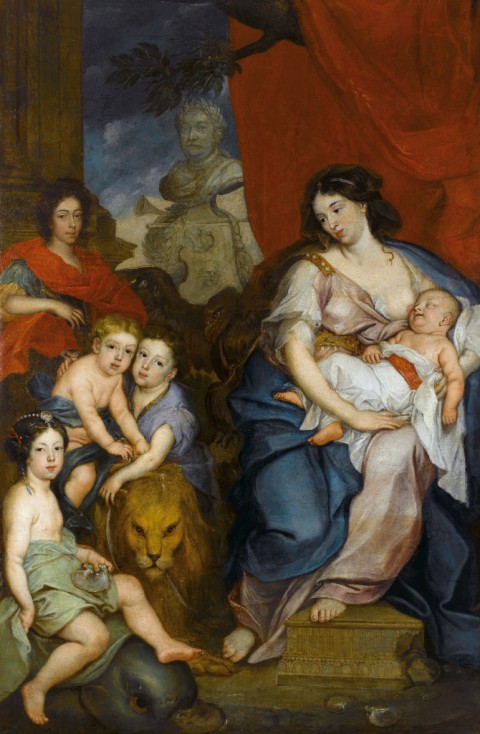Portrait of Queen Maria Kazimiera with Children
karta katalogowa kolekcji
Malarstwo
Jerzy Eleuter Szymonowicz Siemiginowski
about 1684
oil on canvas
215,5 x 142 cm
Wil.1950
One of the most beautiful allegorical Baroque portraits showing Maria Kazimiera (1641–1716, queen since 1674) as the mother of the goddess Gaia-Rhea and the founding mother of the royal Sobieski dynasty. The queen is accompanied by her children: Jakub Ludwik (1667–1737), Aleksander Benedykt (1677–1714), Konstanty Władysław (1680–1726), Teresa Kunegunda (1676–1730) and Jan (1682–1685). The connection between the queen and the goddess of motherhood, life and fertility is reflected in her classical costume, the infant at her breast and the children surrounding her. The eagle, as a rule accompanying the goddess Rhea, is shown in the centre of the composition and embraces with its wings the firstborn son Jakub wearing a crimson robe, the heir to the throne, with his mother, Maria Kazimiera. In the background, Jan III Sobieski is present in the form of a sculpted bust wearing a laurel wreath and with the attributes of glory and victory. His two sons - Aleksander Benedykt and Konstanty Władysław, in stylised ancient apparel, sit astride a lion, the symbol of affiliation to a royal family and a prophecy of valiant deeds in the future. The daughter Teresa Kunegunda perches on a dolphin, holding on her knees a shell containing a pearl; pearls also adorn her hair, signifying predestination involving a throne and mildness of character. The youngest son slumbers on his mother’s lap.
Already in 1917, J. Błoz-Antoniewicz was the first to decipher the mythologizing character of the portrait (Dziecko w sztuce, part III; “Czas” no. 352: 2 May 1917). In his studies, M. Karpowicz dealt with an iconological interpretation and a more precise approach. The attribution of the canvas changed: it was ascribed to Marcin Altomonte, Jerzy Eleuter Siemiginowski or other artists working at the royal court. In the wake of meticulous research, M. Karpowicz established the author as Jerzy Eleuter Siemiginowski. This assumption appears to be correct since the painter in question was a holder of a royal scholarship while studying at the Academy of St. Luke in Rome. His œuvre links the academic knowledge of classicising Baroque with native elements.
The Bavarian State Painting Collections in Munich contain a smaller scale version of the portrait, attributed to Claude Callot (c. 1620–1686), executed after 1685 and thus after the death of little Jan (Jasio), portrayed with the wings of an angel. A drawing made by S. Wyspiański in a sketchbook (1883–1884) on the basis of the portrait is the property of the National Museum in Cracow.
Teresa Pocheć-Perkowska
Polecane

Jerzy Eleuter Szymonowicz Siemiginowski (ca. 1660–ca. 1711)
Jerzy Szymonowicz Siemiginowski was one of the foremost artists employed by King Jan III Sobieski. His works largely defined the …

Marie Casimire de La Grange d’Arquien
Queen Marie Casimire was born the daughter of Henri de La Grange, Marquis d’Arquien, and Françoise de La Châtre. The …

Wilanów Top 15
The Wilanów Top 15 presents the most valuable, extraordinary and beautiful works of art from the Wilanów Palace collection. The exhibits originate from all over the world, from ancient Rome through 17th-century Japan to ateliers of the French masters. Their history reflects the lives and fate of people related to the Wilanów residence. Get acquainted with the exhibits, view and admire them only to rediscover them later in the palace interiors.

Family portrait of king Jan III Sobieski
The State Collection of Art in Wawel (Cracow) contains an oil painting originating from the Broel collection of plated cutlery …

















